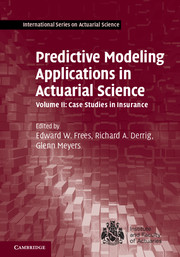Book contents
- Frontmatter
- Contents
- Contributors
- Preface
- Acknowledgments
- 1 Pure Premium Modeling Using Generalized Linear Models
- 2 Applying Generalized Linear Models to Insurance Data: Frequency/Severity versus Pure Premium Modeling
- 3 Generalized Linear Models as Predictive Claim Models
- 4 Frameworks for General Insurance Ratemaking: Beyond the Generalized Linear Model
- 5 Using Multilevel Modeling for Group Health Insurance Ratemaking: A Case Study from the Egyptian Market
- 6 Clustering in General Insurance Pricing
- 7 Application of Two Unsupervised Learning Techniques to Questionable Claims: PRIDIT and Random Forest
- 8 The Predictive Distribution of Loss Reserve Estimates over a Finite Time Horizon
- 9 Finite Mixture Model and Workers’ Compensation Large-Loss Regression Mixture Model and Workers’ Compensation Large-Loss Regression Analysis
- 10 A Framework for Managing Claim Escalation Using Predictive Modeling
- 11 Predictive Modeling for Usage-Based Auto Insurance
- Index
- References
2 - Applying Generalized Linear Models to Insurance Data: Frequency/Severity versus Pure Premium Modeling
Published online by Cambridge University Press: 05 August 2016
- Frontmatter
- Contents
- Contributors
- Preface
- Acknowledgments
- 1 Pure Premium Modeling Using Generalized Linear Models
- 2 Applying Generalized Linear Models to Insurance Data: Frequency/Severity versus Pure Premium Modeling
- 3 Generalized Linear Models as Predictive Claim Models
- 4 Frameworks for General Insurance Ratemaking: Beyond the Generalized Linear Model
- 5 Using Multilevel Modeling for Group Health Insurance Ratemaking: A Case Study from the Egyptian Market
- 6 Clustering in General Insurance Pricing
- 7 Application of Two Unsupervised Learning Techniques to Questionable Claims: PRIDIT and Random Forest
- 8 The Predictive Distribution of Loss Reserve Estimates over a Finite Time Horizon
- 9 Finite Mixture Model and Workers’ Compensation Large-Loss Regression Mixture Model and Workers’ Compensation Large-Loss Regression Analysis
- 10 A Framework for Managing Claim Escalation Using Predictive Modeling
- 11 Predictive Modeling for Usage-Based Auto Insurance
- Index
- References
Summary
Chapter Preview. This chapter is a case study on modeling loss costs for motorcycle collision insurance. It covers two approaches to loss cost modeling: fitting separate models for claim frequency and claim severity and fitting one model for pure premium. Exploratory data analysis, construction of the models, and evaluation and comparisons of the results are all discussed.
Introduction
When modeling insurance claims data using generalized linear models (GLM), actuaries have two choices for the model form:
1. create two models – one for the frequency of claims and one for the average severity of claims;
2. create a single model for pure premium (i.e., average claim cost).
Actuaries have traditionally used the frequency/severity approach, but in recent years pure premium modeling has gained popularity. The main reason for this development is the growing acceptance and use of the Tweedie distribution.
In a typical insurance dataset, the value of pure premium is zero for the vast majority of records, since most policies incur no claims; but, where a claim does occur, pure premium tends to be large. Unfortunately, most “traditional” probability distributions – Gaussian, Poisson, gamma, lognormal, inverse Gaussian, and so on – cannot be used to describe pure premium data. Gaussian assumes that negative values are possible; the Poisson is generally too thin-tailed to adequately capture the skewed nature of insurance data; and the gamma, lognormal, and inverse Gaussian distributions do not allow for values of zero.
Fortunately, there is a distribution that does adequately describe pure premium for most insurance datasets – the Tweedie distribution. The Tweedie is essentially a compound Poisson-gamma process, whereby claims occur according to a Poisson distribution and claim severity, given that a claim occurs, follows a gamma distribution. This is very convenient since actuaries have traditionally modeled claim frequency with a Poisson distribution and claim severity with a gamma distribution.
In this chapter, we explore three procedures for modeling insurance data:
1. modeling frequency and severity separately;
2. modeling pure premium using the Tweedie distribution (without modeling dispersion; in practice, this is the most common implementation of pure premium modeling;
3. modeling pure premium using a “double GLM approach”; that is, modeling both the mean and dispersion of pure premium.
We compare the results of each approach and assess the approaches’ advantages and disadvantages.
- Type
- Chapter
- Information
- Predictive Modeling Applications in Actuarial Science , pp. 39 - 59Publisher: Cambridge University PressPrint publication year: 2016



